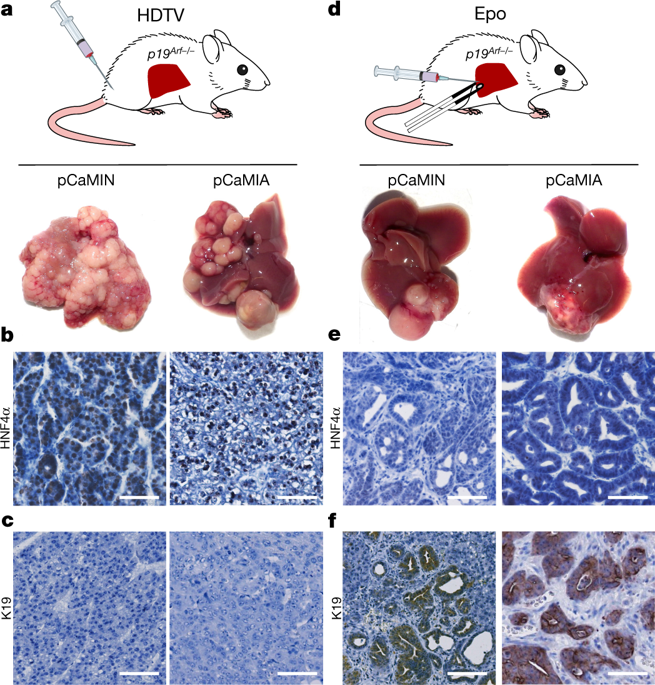Our official English website, www.x-mol.net, welcomes your
feedback! (Note: you will need to create a separate account there.)
Necroptosis microenvironment directs lineage commitment in liver cancer
Nature ( IF 50.5 ) Pub Date : 2018-09-12 , DOI: 10.1038/s41586-018-0519-y Marco Seehawer , Florian Heinzmann , Luana D’Artista , Jule Harbig , Pierre-François Roux , Lisa Hoenicke , Hien Dang , Sabrina Klotz , Lucas Robinson , Grégory Doré , Nir Rozenblum , Tae-Won Kang , Rishabh Chawla , Thorsten Buch , Mihael Vucur , Mareike Roth , Johannes Zuber , Tom Luedde , Bence Sipos , Thomas Longerich , Mathias Heikenwälder , Xin Wei Wang , Oliver Bischof , Lars Zender
Nature ( IF 50.5 ) Pub Date : 2018-09-12 , DOI: 10.1038/s41586-018-0519-y Marco Seehawer , Florian Heinzmann , Luana D’Artista , Jule Harbig , Pierre-François Roux , Lisa Hoenicke , Hien Dang , Sabrina Klotz , Lucas Robinson , Grégory Doré , Nir Rozenblum , Tae-Won Kang , Rishabh Chawla , Thorsten Buch , Mihael Vucur , Mareike Roth , Johannes Zuber , Tom Luedde , Bence Sipos , Thomas Longerich , Mathias Heikenwälder , Xin Wei Wang , Oliver Bischof , Lars Zender

|
Primary liver cancer represents a major health problem. It comprises hepatocellular carcinoma (HCC) and intrahepatic cholangiocarcinoma (ICC), which differ markedly with regards to their morphology, metastatic potential and responses to therapy. However, the regulatory molecules and tissue context that commit transformed hepatic cells towards HCC or ICC are largely unknown. Here we show that the hepatic microenvironment epigenetically shapes lineage commitment in mosaic mouse models of liver tumorigenesis. Whereas a necroptosis-associated hepatic cytokine microenvironment determines ICC outgrowth from oncogenically transformed hepatocytes, hepatocytes containing identical oncogenic drivers give rise to HCC if they are surrounded by apoptotic hepatocytes. Epigenome and transcriptome profiling of mouse HCC and ICC singled out Tbx3 and Prdm5 as major microenvironment-dependent and epigenetically regulated lineage-commitment factors, a function that is conserved in humans. Together, our results provide insight into lineage commitment in liver tumorigenesis, and explain molecularly why common liver-damaging risk factors can lead to either HCC or ICC.The tumour microenvironment determines which type of liver cancer develops, with transformed hepatocytes giving rise to intrahepatic cholangiocarcinoma or hepatocellular carcinoma depending or whether they are surrounded by cells undergoing necroptosis or apoptosis.
中文翻译:

坏死性凋亡微环境指导肝癌的谱系承诺
原发性肝癌是一个主要的健康问题。它包括肝细胞癌 (HCC) 和肝内胆管癌 (ICC),它们在形态、转移潜能和治疗反应方面存在显着差异。然而,将转化的肝细胞转化为 HCC 或 ICC 的调节分子和组织环境在很大程度上是未知的。在这里,我们表明肝脏微环境表观遗传地塑造了肝脏肿瘤发生的镶嵌小鼠模型中的谱系承诺。虽然坏死性凋亡相关的肝细胞因子微环境决定了致癌转化肝细胞的 ICC 生长,但如果肝细胞被凋亡肝细胞包围,则含有相同致癌驱动因子的肝细胞会引起 HCC。小鼠 HCC 和 ICC 的表观基因组和转录组分析指出 Tbx3 和 Prdm5 作为主要的微环境依赖性和表观遗传调节的谱系承诺因子,这一功能在人类中是保守的。总之,我们的结果提供了对肝脏肿瘤发生谱系承诺的深入了解,并从分子上解释了为什么常见的肝脏损伤风险因素会导致 HCC 或 ICC。肿瘤微环境决定了哪种类型的肝癌发生,转化的肝细胞会导致肝内胆管癌或肝细胞癌,取决于它们是否被经历坏死性凋亡或凋亡的细胞包围。
更新日期:2018-09-12
中文翻译:

坏死性凋亡微环境指导肝癌的谱系承诺
原发性肝癌是一个主要的健康问题。它包括肝细胞癌 (HCC) 和肝内胆管癌 (ICC),它们在形态、转移潜能和治疗反应方面存在显着差异。然而,将转化的肝细胞转化为 HCC 或 ICC 的调节分子和组织环境在很大程度上是未知的。在这里,我们表明肝脏微环境表观遗传地塑造了肝脏肿瘤发生的镶嵌小鼠模型中的谱系承诺。虽然坏死性凋亡相关的肝细胞因子微环境决定了致癌转化肝细胞的 ICC 生长,但如果肝细胞被凋亡肝细胞包围,则含有相同致癌驱动因子的肝细胞会引起 HCC。小鼠 HCC 和 ICC 的表观基因组和转录组分析指出 Tbx3 和 Prdm5 作为主要的微环境依赖性和表观遗传调节的谱系承诺因子,这一功能在人类中是保守的。总之,我们的结果提供了对肝脏肿瘤发生谱系承诺的深入了解,并从分子上解释了为什么常见的肝脏损伤风险因素会导致 HCC 或 ICC。肿瘤微环境决定了哪种类型的肝癌发生,转化的肝细胞会导致肝内胆管癌或肝细胞癌,取决于它们是否被经历坏死性凋亡或凋亡的细胞包围。





















































 京公网安备 11010802027423号
京公网安备 11010802027423号